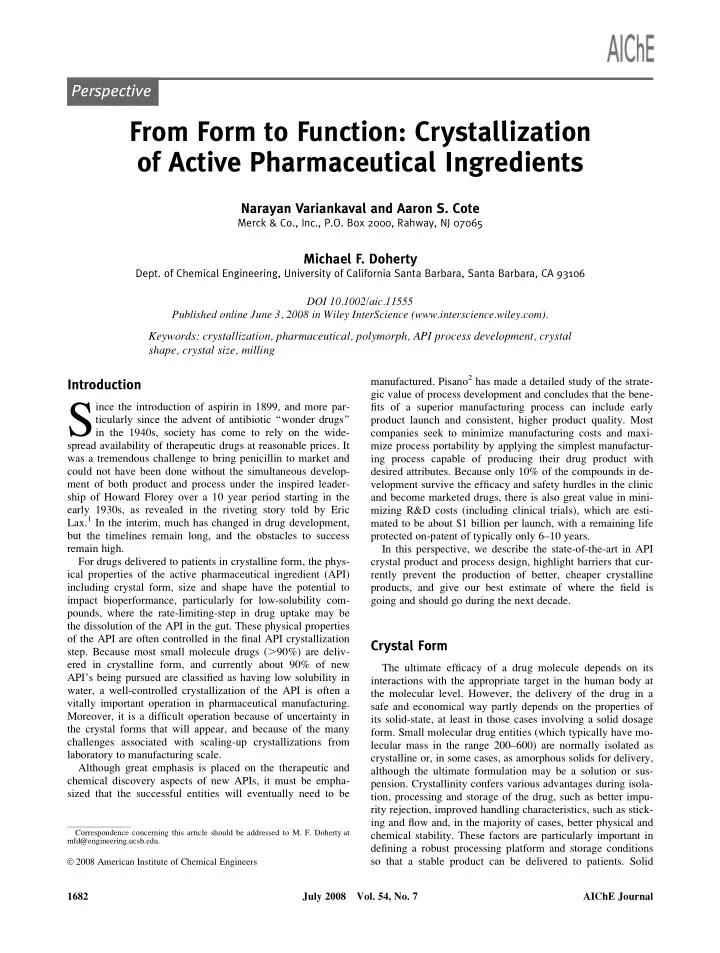

Perspective From Form to Function: Crystallization of Active Pharmaceutical Ingredients Narayan Variankaval and Aaron S. Cote Merck & Co., Inc., P.O. Box 2000, Rahway, NJ 07065 Michael F. Doherty Dept. of Chemical Engineering, University of California Santa Barbara, Santa Barbara, CA 93106 DOI 10.1002/aic.11555 Published online June 3, 2008 in Wiley InterScience (www.interscience.wiley.com). Keywords: crystallization, pharmaceutical, polymorph, API process development, crystal shape, crystal size, milling manufactured. Pisano 2 has made a detailed study of the strate- Introduction gic value of process development and concludes that the bene- S ince the introduction of aspirin in 1899, and more par- fits of a superior manufacturing process can include early ticularly since the advent of antibiotic ‘‘wonder drugs’’ product launch and consistent, higher product quality. Most in the 1940s, society has come to rely on the wide- companies seek to minimize manufacturing costs and maxi- spread availability of therapeutic drugs at reasonable prices. It mize process portability by applying the simplest manufactur- was a tremendous challenge to bring penicillin to market and ing process capable of producing their drug product with could not have been done without the simultaneous develop- desired attributes. Because only 10% of the compounds in de- ment of both product and process under the inspired leader- velopment survive the efficacy and safety hurdles in the clinic ship of Howard Florey over a 10 year period starting in the and become marketed drugs, there is also great value in mini- early 1930s, as revealed in the riveting story told by Eric mizing R&D costs (including clinical trials), which are esti- Lax. 1 In the interim, much has changed in drug development, mated to be about $1 billion per launch, with a remaining life but the timelines remain long, and the obstacles to success protected on-patent of typically only 6–10 years. remain high. In this perspective, we describe the state-of-the-art in API For drugs delivered to patients in crystalline form, the phys- crystal product and process design, highlight barriers that cur- ical properties of the active pharmaceutical ingredient (API) rently prevent the production of better, cheaper crystalline including crystal form, size and shape have the potential to products, and give our best estimate of where the field is impact bioperformance, particularly for low-solubility com- going and should go during the next decade. pounds, where the rate-limiting-step in drug uptake may be the dissolution of the API in the gut. These physical properties of the API are often controlled in the final API crystallization Crystal Form step. Because most small molecule drugs ( . 90%) are deliv- ered in crystalline form, and currently about 90% of new The ultimate efficacy of a drug molecule depends on its API’s being pursued are classified as having low solubility in interactions with the appropriate target in the human body at water, a well-controlled crystallization of the API is often a the molecular level. However, the delivery of the drug in a vitally important operation in pharmaceutical manufacturing. safe and economical way partly depends on the properties of Moreover, it is a difficult operation because of uncertainty in its solid-state, at least in those cases involving a solid dosage the crystal forms that will appear, and because of the many form. Small molecular drug entities (which typically have mo- challenges associated with scaling-up crystallizations from lecular mass in the range 200–600) are normally isolated as laboratory to manufacturing scale. crystalline or, in some cases, as amorphous solids for delivery, Although great emphasis is placed on the therapeutic and although the ultimate formulation may be a solution or sus- chemical discovery aspects of new APIs, it must be empha- pension. Crystallinity confers various advantages during isola- sized that the successful entities will eventually need to be tion, processing and storage of the drug, such as better impu- rity rejection, improved handling characteristics, such as stick- ing and flow and, in the majority of cases, better physical and Correspondence concerning this article should be addressed to M. F. Doherty at chemical stability. These factors are particularly important in mfd@engineering.ucsb.edu. defining a robust processing platform and storage conditions so that a stable product can be delivered to patients. Solid � 2008 American Institute of Chemical Engineers 1682 July 2008 Vol. 54, No. 7 AIChE Journal
Recommend
More recommend